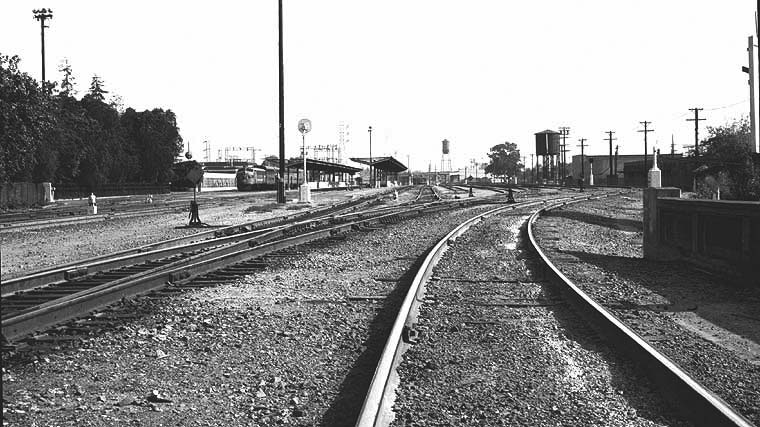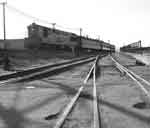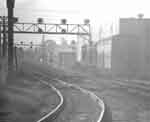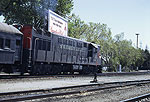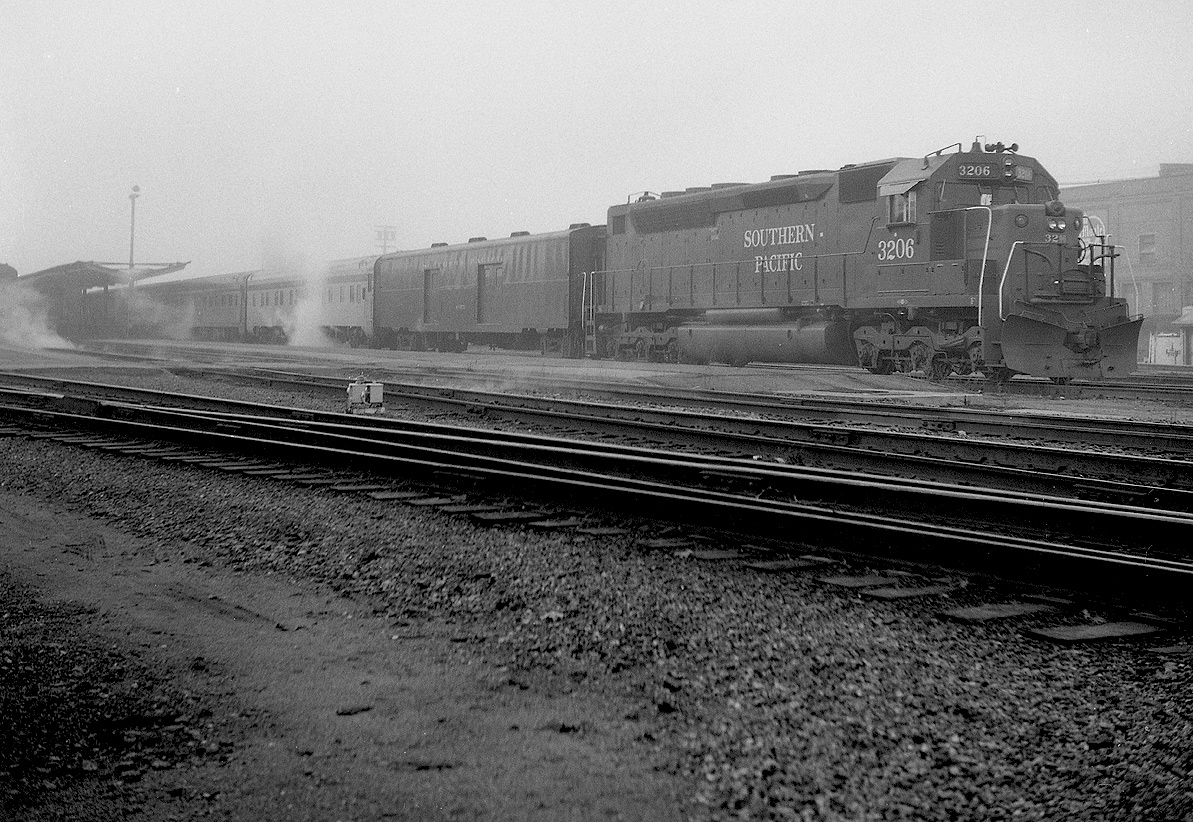|
|
SP's San Jose Cahill St. Depot:
West End Trackage
|
|
|
|
|
| Above is the depot's west (geographic north) end in May, 1969, as seen from the middle of the Freight Lead atop The Alameda overpass. The west end remained unchanged until the installation of CTC in the early 1990's. The adjacent track is the eastbound main leading straight into 5 track. At the far left is tracks 1-4 which lead to the westbound main. That's Train 151, the regular assignment for trusty-dusty ex-Cotton Belt FP-7 6462, when she was not out on the Daylight. This is a weekday, and soon the depot will be busy handling the incoming Fleet, eastbound Del Monte and westbound Daylight. For a large (432k) rendition of the photo, click here. Elsewhere you'll find blueprints and a discussion of a proposed 1965 depot trackage reconfiguration that never happened and a SPINS map of the depot area. |
|
|
|
Just timetable west of The Alameda was a little-used set of tracks that, according to the 1972 SPINS Book , were mostly (passenger car?) "storage", with one track serving "Harold Johnson". They also may have served as team tracks, since the area was paved, but I only saw equipment spotted there on one occasion in the last 40 years: Barnum and Bailey Circus cars in the early 1990's. The location was buried under a parking lot when the San Jose Arena was constructed in the mid - 90's, although the tracks near the farthest inside switch in the photo were still exposed at least as late as 2003. Most of the rail on these tracks was rolled in the 1880's for the Central Pacific. That's the 3034 with #134 in 1968. |
|
|
|
Before ridership began to decline in the early 1960', SP was hard-pressed for track capacity to accomodate all of the equipment on weekends. In the late 1950's I recall seeing cars parked across from Del Monte on the Vasona Line near the branch switch. In the 70's, we routinely set over cars into the otherwise unused Del Monte warehouse tracks located where the Diridon light rail station stands at the geographic west side of the depot. What I never witnessed is what we se here in this August 21, 1960 slide from Don Jewell - cars stored on the team tracks discussed above, and Harriman coaches, not Subs, at that. That's a San Jose City Lines bus in the foreground. - Wx4 collection |
|
|
|
A smoggy-day, long-telephoto look up the half-mile, or so, between the depot and the roundhouse on July 20, 1969. If you had turned around and hiked about 200 feet north from the position of the top photo, this is what you would have seen: freight lead in foreground, eastbound main in center, westbound occupied by overpowered plug #151. The east leg of the wye is out of the photo just to the right of the train's marker light. Lenzen Avenue and the roundhouse appear ahead of the locomotives.
If you'll look closely at the Freight Lead, between the shadow and Lenzen, you'll just barely see the now-fabled "Ice House" switch, serving California Canners and Growers. The Ice-House moniker served as railroad radio shorthand for the signal bridge guarding the north limits of CP Julian through Amtrak's tenure on Caltrain, which ended in May, 2012. I briefly worked there for Cal Can in the early 1970's, and later spotted syrup cars on the spur as a switchman on the Night Depot Job..
|
|
|
|
A hazy afternoon, c3-1973, finds Train Master 3025 lined into the depot by the Alameda herder to latch on to train 143's Galleries on depot track four. At the right, the rear brakeman of the Permanente (presumably) prepares to grab orders off of the post on the Freight Lead. Note the steam wafting from the trackside connection to the left of 143's equipment. The stationary steam plant is just beyond the picture at right. (Wx4 Collection Kodachrome, photographer unknown) |
|
|
|
Possibly later in the same day of the above photo, Train Master 3031 brings an eastbound Commute (note: SP used the term "Commute" to describe its Peninsula local service - never "Commuter"; also: "employees" were "employes" in SP ancient-speak) the last few yards into Cahill. You may have noticed a certain commonality in our San Jose depot photos: whiskey ads. We're not exactly sure who they were directed at, rails or commuters. On late weekday afternoons in those days, it seemed that there was usually a competition going on between the customers and elderly helper conductors to see who climbed on the trains with the highest blood alcohol level. (Wx4 Collection Kodachrome, photographer unknown) |
|
|
|
|
The Lark #75 sits at San Jose on a foggy February 15, 1968. - Wx4 photo |
|
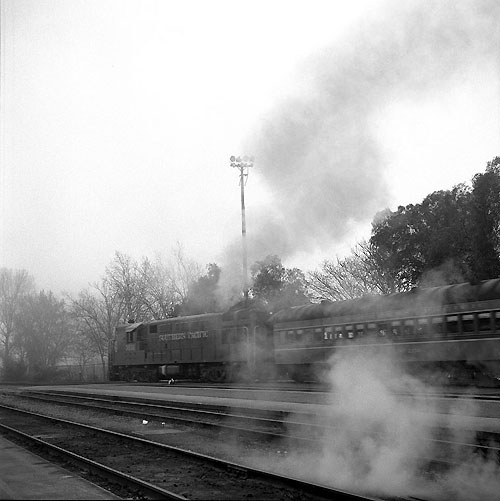 |
This grainy Tri-X Pan photo encapsulates my collective experience with the Commutes, as a passenger, a photographer, and finally, an employee. In fact, my first ride came on a day such as this 60 years ago. Since then, I've seen steam replaced by Train Masters, followed by SDP45's, which in turn gave way to F40's; steam-heated Subs and Harrimans, later supplanted by Galleries, eventually departed in favor of stainless-steel push-pull. Yet, the general feeling of this photo remained consistant through the years...except for the 15 years in the 80's and 90's when those damn run-eight-all-the-time F40 Growlers populated all of the trains.
I was lucky enough to spend the last decade of my career as an engineer in the morning pool out of San Jose, a period when the Growlers' numbers were greatly diminished. Thus, for the most part, this scene again replicated itself - so often that memory claims that my August retirement day started this way...and screams foul at photographs showing a sunny contrary.
For the record: I shot this photo of Train Master 3031 accelerating a Fleet train out of Cahill Street on March 15, 1969, than 40 years plus a few months before I retired.
- E.O.
|
|
 earlier times earlier times
|
 |
NEW 5-2023: The new San Jose depot at Cahill St. opened on the last day of 1935. Quile a bit of work on the platforms and sheds still remained when this photo was recorded on the 26th. - Shasta Division Archives |
This photo by George Janes, a one-time Bayshore Towerman, has made the rounds - it appears on page 411 in Bob Church's Southern Pacific Ten-Coupled Locomotives, and from what I'm led to believe, numerous private collections. The uniqueness of the event, and the fact that George shot the photo in San Jose, requires that it be seen here.
What we see here is 4-10-2 on the head end of the Oakland Daylight, waiting to depart San Jose on March 29, 1953. Yep, this was more-than-ample power for a train headed along the San Francisco Bay tideflats, but as you may have surmized, this was a special occasion.
That day the California Nevada Railroad Historical Society (Cal-Nevada) sponsored an excursion from Oakland to Monterey that featured the 5011 from San Jose to Watsonville Jct., and again from Watsonville Jct. to Oakland. The down portion out of Oakland was handled by elderly P-1 Pacific 2411 (possibly the last one running with an as-built inside-bearing trailing truck). The Monterey legs were drawn by ten-wheeler 2375. On the return, the regular Daylight equipment was spliced between the engine and the excursion cars. Fare: $6.50.
In 1953, the 4-10-2's made brief appearances in Central California after being kicked-out of the Southwest deserts by diesel. Some of them wound up in Oregon, while the balance never made it past storage at Sacramento. Though we really don't know, this photo may document the start of 5011's eventual journey to Oregon, where she was retired on December 28, 1954 along with the 5033, leaving the still-extant-today 5021 as the lone Southern Pacific type on the Southern Pacific. |
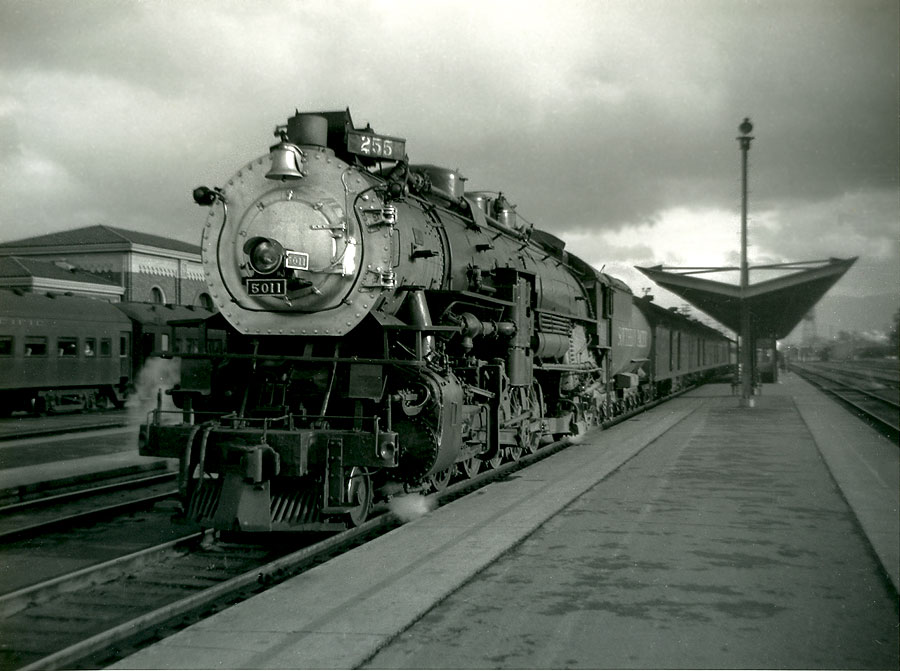
Thanks to Evan Werkema and Dave Hambleton for providing info. I believe that George may have been a shirttail relative of mine, BTW. |
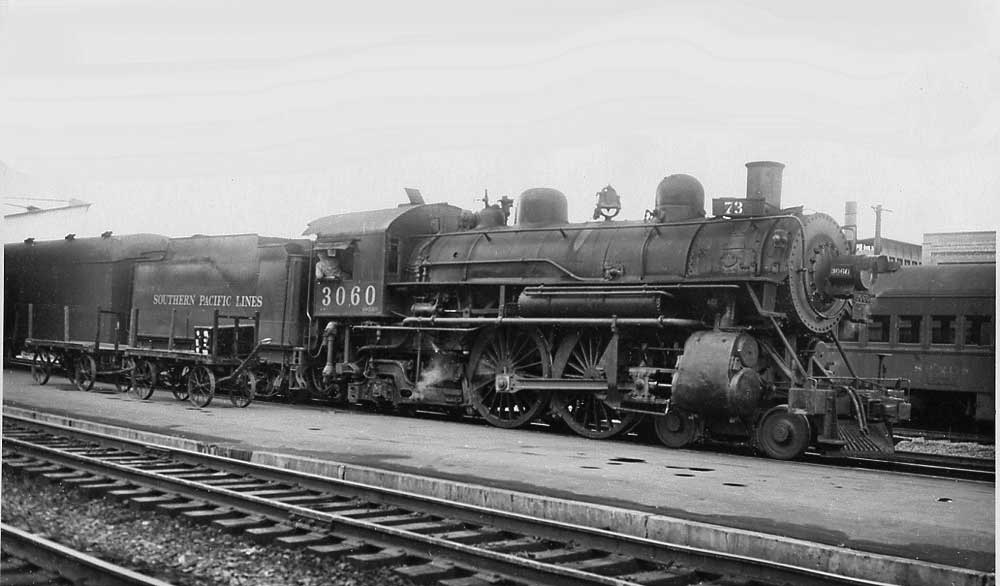 |
And what would the Oakland Daylight be without the the Oakland Lark? This shot was taken at Cahill by an unknown photographer on a gloomy day sometime during the period from December, 1935, when Cahill replaced the San Pedro depot, and May 1940, when SP set the loco out to pasture. The 3060 seems to have been a Bay Area regular at least in mid/late career, as a beautiful shot in my collection by Edwin Hoffeld shows the loco at Niles on the head end of the #232 accomodation run shortly after the loco received its booster in 1924.
Beyond the beauty of the high-stepper, what intigues me is a bit of minutia - the condition of the platform. Its curb is well-broken for something that was poured 5-10 years before (Cahill's construction was a drawn-out affair), suggesting that the fill used to raise the depot's throat over the Alameda was not compacted very well, and that the weight of passing trains finished the job.
|
| AND, here is one of 3060's dwindling mates at about the same time. This gorgeous rod-down image from a Doug Richter negative is a little out of place here, as it was shot one evening up the tracks behind the roundhouse (that's the College Park Yard RIP tracks in the background) - but what the heck. When Richter made the photo on October 10, 1937, 3071 and 3060 were only two of at most nine (by my count using D&S's Compendium) A-3 4-4-2's remaining under steam, out of an original class of 47. Hoards had been retired earlier in the Depression, or otherwise rebuilt into A-6's and 0-8-0's. Fittingly for our purposes here, SP retired both locos on the same day, May 1, 1940, and likewise scrapped them at Bayshore within days of each other in June, a good end preferrable to the ignominity of helper service on Beaumont Hill that occasionally befell the remaining few A-3's. Incidentally, the 3071 originally came from the SPdeM in 1913 as a coal burner, but was converted to oil within months. |
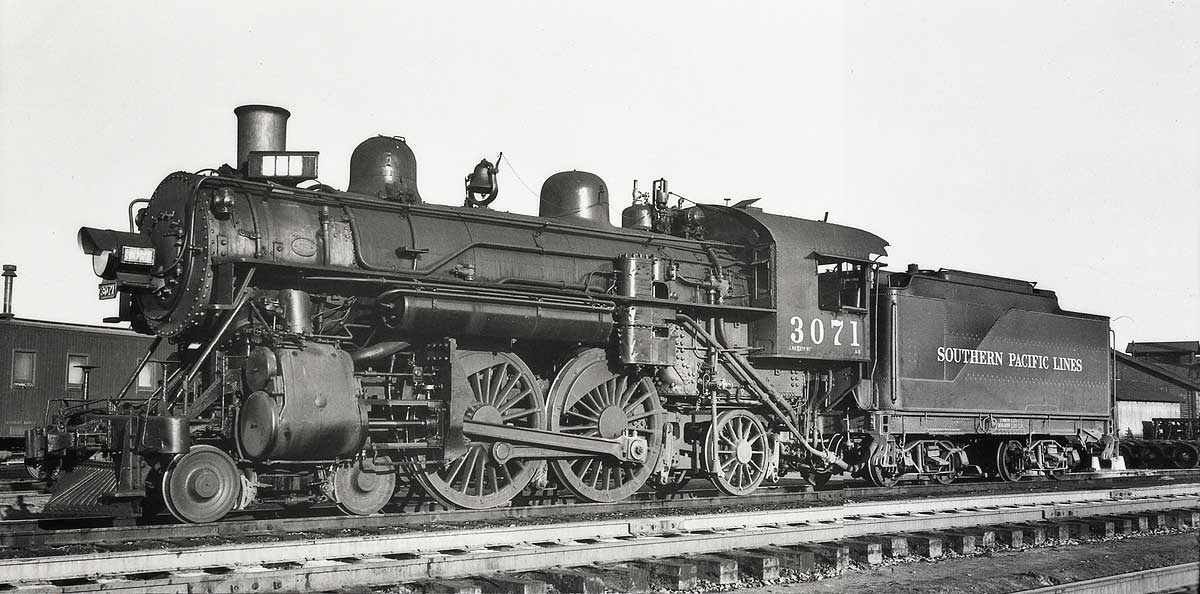 |
|
|
|
|
|
|
|
